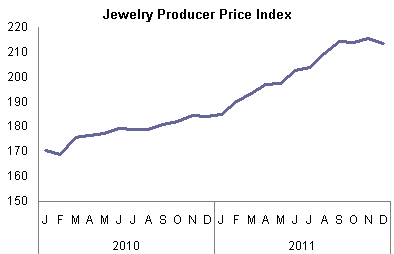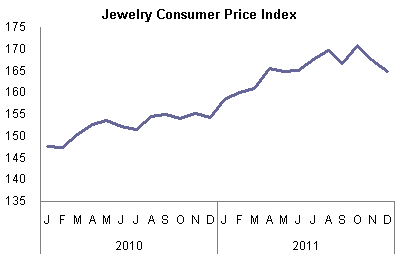IDEX Online Research: Jewelry Prices Soften in December, But Climb for Year
January 29, 12
(IDEX Online) – Despite reasonably solid consumer demand, some jewelers apparently increased price discounting prior to Christmas, creating a deflationary trend in December at the supplier and the retail levels, when compared to November jewelry prices.
The full JCPI analysis is available to IDEX Online Research subscribers and IDEX Online members here.
Further, the chasm between jewelry retail prices and jewelry supplier prices remained wide in December, continuing a trend which characterized most of 2011.
At some point, this vicious cycle will end. In the meantime, wholesale jewelry prices continued their relentless upward track, while retail jewelry prices inched upward in December 2011 versus the prior year as well as for the full year of 2011. The margin squeeze that is affecting specialty jewelers will not have a happy ending, in our opinion.
For December, the Jewelry Producer Price Index (JPPI) stood at 213.6 versus November’s 215.4; a year ago, the JPPI stood at 184.1. Here’s what this means:
· Wholesale jewelry prices in December fell by about 0.8 percent versus November 2011.
· Wholesale jewelry prices rose by about 15.8 percent on a year-to-year comparison basis.
· On a full year basis – 2011 versus 2010 – wholesale jewelry prices rose by 13.9 percent.
· The graph below summarizes the JPPI over the past two years.
 Source: BLS |
For December, the Jewelry Consumer Price Index (JCPI) stood at 167.3 versus November’s 167.3; a year ago, the JCPI stood at 154.3. Here’s what this means:
· Retail prices of jewelry in December fell by about 1.4 percent compared to November 2011.
· Retail jewelry prices in December rose by about 7.0 percent year-over-year.
· Retail jewelry prices in 2011 rose by 8.4 percent versus 2010.
· The graph below summarizes the JCPI over the past two years:
 Source: BLS |
The Bottom Line: Unusually High Inflation in 2011
Jewelry price inflation hit record levels in 2011, with jewelry retail prices up by 8.4 percent and jewelry supplier prices up by 13.9 percent. In the twenty-three year history of jewelry price inflation data, no period has shown as much annual inflation as 2011. Most of this hyperinflation was caused by rising prices of precious metals and polished diamonds.
Worse, the disparity between supplier price inflation and retail price inflation continued throughout 2011. Here’s how this disparity in inflation rates between producers and retailers affects the American jewelry industry: the margin squeeze that specialty retail jewelers have felt since 2009 continues to manifest itself.
While commodity prices – gold, silver, platinum – seem more or less stable currently, they correlate somewhat to the global economic climate. According to the latest forecasts from the OECD, the economies of most of the diamond-consuming countries are expected to grow only modestly in 2012. This could lead to further disparity between retail jewelry prices and supplier prices. If consumer demand weakens, retail jewelry prices will likely slip. However, when the global economy weakens, investors often buy gold as a safe harbor for their money; this will push the price of gold higher. If gold prices start rising again, jewelry suppliers will have no choice but to raise their prices. This will intensify the current margin squeeze that retailers are experiencing.
The table below provides a summary of inflation rates in the
 Source: Various markets |
Jewelry Inflation Outlook: Uncertainty Near Term, Higher Long Term
It would be easy to forecast inflation for the jewelry industry if all of the commodities involved in the forecast were used exclusively by the jewelry industry. While that may be the case for polished diamonds, precious metals are used by a number of other industries; further, gold is an international currency that plays in a financial arena of its own.
· Jewelry Industry Long Term Outlook – Demand from emerging economies such as
· Global Economic Outlook for 2012 – The latest OECD data points to decelerating economic growth, which will likely hinder consumer demand near term.
· Financial Markets Outlook for 2012 – With continued volatility in the world’s stock markets and uncertain valuations related to stocks, bonds and other hard assets, investors are likely to move to the safe haven that gold offers.
The bottom line: inflation is headed higher over the longer term. Jewelry suppliers and retailers should use periods of weakness in commodity prices to add to their inventory.
The full analysis is available to IDEX Online Research subscribers and IDEX Online members here. Click here for more information on how to subscribe or become a member.